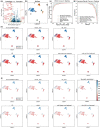Enhanced annotation of CD45RA to distinguish T cell subsets in single-cell RNA-seq via machine learning
- PMID: 38023329
- PMCID: PMC10676521
- DOI: 10.1093/bioadv/vbad159
Enhanced annotation of CD45RA to distinguish T cell subsets in single-cell RNA-seq via machine learning
Abstract
Motivation: T cell heterogeneity presents a challenge for accurate cell identification, understanding their inherent plasticity, and characterizing their critical role in adaptive immunity. Immunologists have traditionally employed techniques such as flow cytometry to identify T cell subtypes based on a well-established set of surface protein markers. With the advent of single-cell RNA sequencing (scRNA-seq), researchers can now investigate the gene expression profiles of these surface proteins at the single-cell level. The insights gleaned from these profiles offer valuable clues and a deeper understanding of cell identity. However, CD45RA, the isoform of CD45 which distinguishes between naive/central memory T cells and effector memory/effector memory cells re-expressing CD45RA T cells, cannot be well profiled by scRNA-seq due to the difficulty in mapping short reads to genes.
Results: In order to facilitate cell-type annotation in T cell scRNA-seq analysis, we employed machine learning and trained a classifier on single-cell mRNA count data annotated with known CD45RA antibody levels provided by cellular indexing of transcriptomes and epitopes sequencing data. Among all the algorithms we tested, the trained support vector machine with a radial basis function kernel with optimized hyperparameters achieved a 99.96% accuracy on an unseen dataset. The multilayer perceptron classifier, the second most predictive method overall, also achieved a decent accuracy of 99.74%. Our simple yet robust machine learning approach provides a valid inference on the CD45RA level, assisting the cell identity annotation and further exploring the heterogeneity within human T cells. Based on the overall performance, we chose the support vector machine with a radial basis function kernel as the model implemented in our Python package scCD45RA.
Availability and implementation: The resultant package scCD45RA can be found at https://github.com/BrubakerLab/ScCD45RA and can be installed from the Python Package Index (PyPI) using the command "pip install sccd45ra."
© The Author(s) 2023. Published by Oxford University Press.
Conflict of interest statement
None declared.
Figures




References
-
- Abadi M, Barham P, Chen J. et al. TensorFlow: A System for Large-Scale Machine Learning. In: Proceedings of the 12th USENIX conference on Operating Systems Design and Implementation (OSDI'16). 2016. https://www.usenix.org/system/files/conference/osdi16/osdi16-gu.pdf.
-
- Ali Y, Al-Hroot K.. Bankruptcy prediction using multilayer perceptron neural networks in Jordan. ESJ 2016;12:425. 10.19044/ESJ.2016.V12N4P425 - DOI
LinkOut - more resources
Full Text Sources
Research Materials
Miscellaneous

